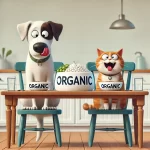Introduction
Choosing the right organic pet food can be a challenge, especially for new pet owners. With numerous options on the market, understanding what makes pet food truly “organic” and selecting the best quality for your pet’s health is essential. This guide will help you navigate the world of organic pet food, covering everything from reading ingredient labels to identifying quality ingredients, and avoiding lower-quality products.
What is Organic Pet Food? Understanding Definitions and Certifications

Organic pet food must meet specific standards to be certified. Here’s what you should know about the key requirements:
- USDA Organic Certification: In the U.S., the USDA “Organic” label means the food meets strict standards, such as no synthetic pesticides, GMOs, or artificial additives.
- Ingredient Sourcing: For organic certification, all ingredients must come from farms that adhere to organic practices, ensuring a clean and natural source.
- Higher Nutritional Standards: Organic pet food generally aims to include high-quality ingredients, supporting better nutrition for your pet.
Knowing these standards will help you choose products that meet verified organic criteria, so you’re getting the quality you’re paying for.
Tips for Reading Pet Food Labels
Understanding labels is crucial to selecting high-quality organic pet food. Here’s a breakdown of what to look for:
| Label Element | What to Look For |
|---|---|
| Ingredient List | Look for organic meat sources as the first ingredient (e.g., organic chicken, beef, fish). |
| Additives and Fillers | Avoid foods with artificial preservatives, colors, or by-products. |
| Certification Seals | Look for USDA Organic or similar certifications that guarantee organic sourcing. |
| Single-Source Proteins | Helps prevent allergies and simplifies the ingredient profile for pets with sensitive stomachs. |
| Natural Additions | Look for added Omega-3 fatty acids, probiotics, and antioxidants for enhanced health benefits. |
Reading labels thoroughly will help you discern quality ingredients from fillers and unnecessary additives. Understanding these label elements is one of the best ways to choose truly high-quality organic pet food.
Red Flags to Watch for in Lower-Quality Organic Pet Foods
Unfortunately, not all pet foods labeled “organic” are created equal. Here are some red flags to avoid when choosing a product:
- Generic Ingredients: Labels that list “meat” or “poultry” without specifying the source are a sign of lower-quality protein.
- Artificial Additives: Even organic pet foods can sometimes include preservatives or flavor enhancers. Avoid products with unfamiliar chemical names.
- No Certification: If the product lacks a clear certification seal, it may not meet organic standards, even if marketed as “natural” or “holistic.”
- Excessive Fillers: Ingredients like corn, wheat, and soy are not ideal in pet food, especially for pets with allergies or sensitive stomachs.
By keeping these red flags in mind, you’ll be better equipped to select a genuinely high-quality organic pet food that benefits your pet’s health.
Common Questions about Organic Pet Food: Answered
1. Is organic pet food better for my pet?
- Organic food generally offers cleaner ingredients without harmful additives or pesticides. Many pet owners report improvements in their pet’s skin, coat, and energy levels after switching to organic.
2. Why is organic pet food more expensive?
- Organic farming and sourcing are more labor-intensive, and the ingredients are often higher quality. The added cost reflects the nutritional and health benefits.
3. Can all pets eat organic food?
- Yes, organic pet food is suitable for most pets. However, for pets with specific health conditions, consult your veterinarian before making a change.
Gradually Transitioning to Organic Food: Step-by-Step Tips
Switching your pet to organic food requires a gradual approach to avoid digestive upset. Here’s a simple transition plan:
- Days 1-3: Mix 25% organic food with 75% of the current food.
- Days 4-6: Increase to 50% organic food and 50% current food.
- Days 7-9: Feed 75% organic food and 25% current food.
- Day 10+: Transition fully to organic food.
Recommended Organic Pet Food Brands
For new pet owners, choosing a reputable brand can simplify the selection process. Here are three high-quality organic pet food brands:
- Castor & Pollux Organix: Known for USDA-certified organic options, this brand offers high-quality ingredients with no artificial additives.
- The Honest Kitchen: This brand provides minimally processed, human-grade organic pet food, making it an excellent choice for health-conscious pet owners.
- Tender & True: With USDA organic certification, Tender & True offers a variety of single-protein formulas to cater to pets with sensitivities.
These brands meet high standards and provide excellent options for pet owners seeking reliable, organic products.
External Resources for Further Reading
Conclusion
Choosing high-quality organic pet food for your pet involves understanding certifications, reading labels, and recognizing red flags. With the right knowledge and careful selection, organic pet food can support your pet’s health and wellness. By following this guide and consulting reputable sources, you’ll be well-equipped to provide your pet with the best nutrition possible.

